Liquid Iron
The soil in my garden started out pretty much clay. Over the last few years I have been trying to move to more organic gardening in order to bring the soil back to health and get more organic materials into it.
I think I have been doing an decent job, but the Ph or my soil remains high (this a problem with my well water in general too -- high Ph).
As a result my roses exhibit both magnesium and iron deficiencies at different parts of the summer, and I treat them by using about 1/4 cup of Epsoms salts per rose twice a summer, and about 6 oz of Bonide's liquid iron chleate per plant twice a summer applied directly to the soil.
So my question is this -- does this negatively impact the soil life? Will either of these remediation mechanism (both of which work well in terms of treating the rose symptoms), will these work against my efforts to get life into the soil?
Anyway, any opinions or ideas are greatly appreciated.
Comments (22)
strawchicago z5
9 years agolast modified: 9 years agoHi Nicholas: The town next to me reported their water pH at 8.9, even higher than baking soda. My water is 8.5, tested with fish-tank litmus paper.
From the soil forum, I learned that magnesium is what makes clay soil sticky. My soil was tested EXCEEDINGLY HIGH IN MAGNESIUM, by EarthCo,, a professional soil testing company. Therefore putting Epsom salt (magnesium sulfate) only make it worse, since Epsom salt is salty ... clay soil is already high in salt.
I spent hours researching on iron deficiency for high pH soil. U. of Illinois Extension conducted a study whether or not alkaline soil is deficient in iron or manganese. Their verdict: it's manganese deficiency (diffused yellowing), rather than iron deficiency (clear, defined yellow veins) for my region. I'm next to a limestone quarry.
Thus before applying chelated iron, it's best to differentiate between manganese vs. iron ... those 2 are often confused. From the blueberry forum and from several U. Extensions, I learned that making soil FLUFFY with organic matter, will help roots to acid-phosphatase ... Roots, if given fluffy soil, can secret acid to overcome high pH soil. Dr. Huey rootstock is very good at this.
Another approach is to mix fluffy, acidic matter such as pine-bark (pH 4), cracked corn (pH 4). Peat moss at pH 4 DOES NOT work with dense, compact, and heavy clay like mine, since peat moss's fine-particles glue up with my sticky clay into concrete. Large size, fluffy, and acidic organic matter like leaves are best. Leaves pH is between 5 to 6 ... but becomes more alkaline as it decompose.
nicholas_delo 7a
Original Author9 years agolast modified: 9 years agoThanks for the info strawberry.
I believe I get both iron and magnesium deficiencies, because, at different times of the the summer, my roses begin to exhibit on or the other symptoms -- meaning yellowing in older leaves, and then later in the summer, yellow new growth.
I used foliar sprays of both Epsom salts and iron during one season, and this had a positive impact, but i didn't care for the increasingly difficult spraying regimen.
So, what I'd like to do is come up with a better way of maybe fixing the problem for good, if that is at all possible.
Related Professionals
Waunakee Landscape Architects & Landscape Designers · Garden City Landscape Architects & Landscape Designers · Frisco Landscape Contractors · Mooresville Landscape Contractors · Caldwell Landscape Contractors · Columbine Landscape Contractors · Dickinson Landscape Contractors · Elmhurst Landscape Contractors · Kailua Landscape Contractors · McLean Landscape Contractors · Paramount Landscape Contractors · Reedley Landscape Contractors · Seymour Landscape Contractors · Wailuku Landscape Contractors · Silver Firs Landscape Contractorsnicholas_delo 7a
Original Author9 years agolast modified: 9 years agoOh you said "Manganese!" Well, I do know that if I treat my roses with chleated iron, they green up instead of yellow. I did researcht he difference a while back and cannot recall the specifics, but at the time I was fairly sure it was iron problems and not manganese.
nicholas_delo 7a
Original Author9 years agolast modified: 9 years agoOk, aside form the above conversation, let's think of it this way to simplify things --
If I were hell-bent on pouring 6 ounces of Bonide liquid iron and sprinkling 1/4 cup of epsoms salt around the base of my roses twice this summer, would this be poisonous to the biological life of the soil?
I guess this is what I really want to know.
strawchicago z5
9 years agolast modified: 9 years agoHi Nicholas: Our region's manganese deficiency shows up clearly on my rhododendrons and the neighbor's red maple tree. My neighbor used a foliar spray with Ammonium sulfate, chelated iron, chelated manganese, etc.. and her rhodies & azaleas were dark-green ... I was impressed.
With own-root roses, I get multiple deficiencies, as stated in the below link: "The availability of many plant nutrients in soils, including iron, zinc, copper, and manganese (Mn), is reduced at high pH values. Iron chlorosis in plants, caused by inadequate iron, is a common problem in alkaline soils. Phosphate, a macronutrient, may also be limited in these high pH soils due to its precipitation in the soil solution."
I agree with the last statement. When I use horse manure (has lime added), my roses bloom less (less phosphorus and less potassium). Potassium deficiency is often confused with MAGNESIUM (Mg) deficiency, since both result in yellowing of lowest & oldest leaves. Wikipedia states clearly "Magnesium (Mg) deficiency is a detrimental plant disorder that occurs most often in strongly acidic, light, sandy soils, where magnesium can be easily leached away."
http://en.wikipedia.org/wiki/Magnesium_deficiency_(plants)
So in alkaline soil, iron and manganese (Mn) deficiencies are common, but NOT magnesium (Mg) deficiency. The most permanent solution I did was to dig up the rose, and mix in fluffy, large-chunk acidic materials like leaves, pine bark, and cracked corn, as suggested by the below link to add organic matter.
I finally got my roses to be dark-green last fall: by bringing down the pH of my hard-well-water, with potassium sulfate, lower salt index, with a good % of sulfur to bring down the pH. I don't have any yellowing of older leaves, since that takes care of potassium deficiency, plus releasing iron, manganese, copper, and zinc from lowering pH.
Folks use potassium chloride to soften hard-well. Drawback: that has salt index of 112.6, vs. lower salt index in potassium sulfate of 32, plus 21% sulfur. The other advantage of using potassium sulfate is MORE blooms.
I overkilled on potassium sulfate in the spring, which I counted over 60 blooms on Frederic Mistral (which used to give me less than 10 blooms on horse manure). Too much potassium sulfate resulted in darker-green leaves, more blooms, but the bloom-quality declined: faded, less petals. From that time on, I only use enough to lower my alkaline tap water: 1 teaspoon per 1 gallon is plenty.
The other temporary solution I did: applying ammonium sulfate DID NOT work. It result in leaf-burn, due to high-salt content of ammonium sulfate (salt index over 80). See below picture of the brown-salt-burn leaf margin on a pale Sonia Rykiel rose.
Here is a link that might be useful: Solutions to high pH problem
strawchicago z5
9 years agolast modified: 9 years agoHi Nicholas: In response to your question "If I were hell-bent on pouring 6 ounces of Bonide liquid iron and sprinkling 1/4 cup of epsoms salt around the base of my roses twice this summer, would this be poisonous to the biological life of the soil?"
I won't use Epsom salt (magnesium sulfate), since alkaline clay soil is already high in magnesium. The salt in Epsom salt is enough to zap earthworms. Liquid iron Bonide: can't hurt, if diluted with water.
Anything in a solution is safer than in a powder. I killed plenty of worms by mixing in elemental sulfur (granules) ... but worms don't mind when I lowered my hard-well water to neutral zone with potassium sulfate. From what I had witnessed with my neighbor's acid-plants, the foliar spray is much safer and more effective than applying to the root.
I applied iron sulfate to 3 of my rhododendrons and killed them, when concentrated chemicals are applied at the root zone, it's very harsh to the roots and living organisms. Below are Pat Austin's healthy leaves, when I brought the pH of my well-water (pH 8.5) down to that of rain water (pH 5.6 in the East coast, and at pH 6 in my Chicagoland).
nicholas_delo 7a
Original Author9 years agolast modified: 9 years agoThanks Strawberry. This gives me a lot to go on and research in preparation for the spring.
I guess my best first step is to have my soil sampled so I know exactly what I have and then can plan a course of action.
Cheers
bcroselover
8 years agoHi everyone,
I got into this thread because I see one of my potted roses is slightly chlorotic. I know my soil here is roughly neutral, just slightly on the alkaline side. I guess the rose could use an iron chelate foliar spray. But I'm really interested in cornmeal as a fertilizer, recommended in place of bone meal, and said to be quite acid so as to bring down the pH of my soil. I also have a hydrangea that's a little chlorotic. And it's quite possible that I had too much phosphorus in my organic fertilizer because I used GaiaGreen's "Power Bloom" which is 2-8-4. It has fishbone meal, bone meal, glacial rock dust, mined potassium sulphate, fossilized carbon complex, rock phosphate, greensand, kelp meal gypsum and bat guano. But I guess the bottom line is 2-8-4. Except I would expect these ingredients to be slow working. But now I have some chlorosis in a few places whereas I've never had it before on this property. I was wondering if cornmeal would help. And when people talk about "cracked corn" is cornmeal off the grocery shelf just the same? I live in a little village of 500 people in British Columbia. I have to drive 1-1/2 hours to a farming supply store.strawchicago z5
8 years agolast modified: 8 years agoHi bcroselover: Cornmeal off the shell is so refined, that's very little nutrients left. Plus cornmeal off the shell is high in corn gluten. Corn gluten meal is corn protein, and is used as an herbicide. I already tested that stuff for black spots, it was worthless, and attracted flies. Thank God it's only $1 box which I trashed.
Since your roses are in pots, I will ask a few questions to understand better:
- What percentage of rain water you get, versus % of using tap water for your pots. The problem might be VERY ALKALINE tap water, which can be detected by $5 litmus-paper, used for fish-tank. Stores that have fish tanks, like Walmart, sell that. Since gypsum has calcium plus 17% sulfur ... I used SOLUBLE gypsum to green-up my roses. Sulfate of potash is even better, at 21% sulfur, that green-up faster, due to sulfur's action in lowering the pH.
Regarding "Power Bloom" fertilizer at 2-8-4: You are right about too much phosphorus, it's the bone meal that's causing problem. Bone meal can't dissolve when the pH is above neutral, so it gunks up and burns the root, resulting in yellowing. There's one tomato which I put bone-meal in the planting hole, and it was stunt & yellowish. One summer I threw bone meal on my geraniums, and their leaves became yellowish immediately.
I would NOT drive 1 1/2 hours to a farm-supply to get cracked corn, since that is meant to break up compact-clay, rather than for pots. I tested mixing cracked corn into pots: it increased potting-soil's moisture retention ability, but I did not notice much greening up. What's effective in Greening-up was Kelp, with all the trace elements. But Kelp has salt, so less is best. I would use SOLUBLE gypsum to green up your roses I pots. That worked for me before. SOLUBLE gypsum has low-salt index of 8, versus 34 for sulfate of potash.
When bone meal gunks up or glues up with soil ... roots can't breath, thus becoming yellowish. The same thing happened when I tested chemical-high-phosphorus at NPK 2-20-20. When high-phosphorus hit alkaline soil, it crystallizes the soil, causing soil to become more compacted. Roots got choked, and plants become yellowish. Gypsum is known to loosen and break-up hard clay, and soluble gypsum also loosen up the crystallization from using high-phosphorus.
I tested many high-phosphorus MORE-BLOOM formulas (soluble): they form crystals at the bottom of my bucket when I used alkaline-tap-water. I had to use vinegar to dissolve the sticky crystals off my bucket.
If the entire rose is yellowish, then use SOLUBLE gypsum ... it's sold for $16 per 5 lb. on Kelp4Less (free shipping). Local stores also sell small bag of granular gypsum for $6 ... you can dissolve that in rain-water to make SOLUBLE gypsum. If only the lowest leaves of your roses are yellowish, then it's potassium deficiency, and sulfate of potash is VERY FAST in greening-up. SOLUBLE Sulfate of potash is cheap on Amazon. Both gypsum and sulfate of potash supplies SULFUR, which LOWERS the pH toward neutral zone. Once the pH is neutral, then trace-elements are released to the soil, enabling green-up.
The other solution is to leave the high pH of soil and water alone, but supply trace elements to green-up. There's one poster fragrancenutter (zone 10b) who posted pics. of her Sonial Rykiel rose with dark-green leaves & deep-color blooms. She stated "Soil is amended with bentonite clay, sulfuric acid, iron sulfate, chook poo, and a wetting agent before planting." Chook poo is an odorless Australian chicken manure-blend. Sulfuric acid is to lower the pH (very caustic). Iron sulfate I don't recommend, since I already tested it, it burns roots.
I don't recommend chicken-manure for pots (very hot & high in salt, and burns roots in contact). Betonite clay is best for the ground, not pots. However, I would top your pots with CRUSH red-lava-rocks, it has high % of iron, plus other trace elements to green up. My roses are deep-green this year, thanks to my dumping red-lava-rock last year, despite my soil pH at 7.7, and tap water pH at 8.6.
Betonite clay: according to Wikipedia, "There are different types of bentonite, each named after the respective dominant element, such as potassium (K), sodium (Na), calcium (Ca), and aluminium (Al). Bentonite usually forms from weathering of volcanic ash, most often in the presence of water. "
bcroselover
8 years agoWow, this is soooo helpful, thanks so much! Usually this time of year, most of watering would come from the tap, but we just had a period of prolonged rain, so water has been by rain for about two or three weeks. And I have one rose in a pot that's in beginning stages of chlorotic, and one in the ground less so, but not very green, though all the others are a good green. I was really generous with Power Bloom, and I'm afraid the one in the pot is in a confined environment. I must have gone overboard. Our local hardware store garden centre does carry a horde of soil amendments, I'll go see what I can find and order soluble gypsum if I can't find it. Crushed red lava rocks is doubtful. Do you think potassium sulfate or soluble gypsum would substitute for aluminum sulfate to bring down the pH of my hydrangeas? I was going to use the aluminum but I like to go organic, and don't think of it as being a natural soil amendment. Last I tested my soil in two or three locations here, it was about 7.2 pH. This is coniferous forest country and I imagine our soil would naturally be acidic, but I live in an area full of birch trees, My property is swamped with birch leaves every year and I believe they're thought to be alkaline.
strawchicago z5
8 years agolast modified: 8 years agoThank you, bcroselover, for very thoughtful questions which help me too as I search for the answer. To lower the pH, SOLUBLE sulfate of potash (21% sulfur) is much better than Aluminum sulfate. Aluminum is known as a toxin, and hurt root growth. I used SOLUBE sulfate of potash for my tall-summer-phlox and its blooms are twice bigger & more blue that the ones without sulfate of potash.
Here's an excerpt from below link: "Aluminum doesn't acidify the soil, but aluminum becomes more readily available to plants as the soil becomes more acid. Ph is a measure of H+ ions in the soil. It has nothing to do with aluminum. ... If you just want to use it to keep hydrangeas blue, then fine, but sequestered iron is more useful for rhododenrons. Also works on the hydrangeas, in my experience. Sold in the UK as Sequestrene Iron Tonic, but other companies produce it with added ingredients such as magnesium or seaweed extracts. A useful remedy for chlorotic lime hating plants, and useful for blueberries too, because they, like all the other lime haters, have trouble taking up iron in alkaline conditions.
bcroselover
8 years agoWow, the stackexchange discussion group really adds to this one. Believe me, that's the end of my plans to use aluminum sulfate. But the guy who went to the mountains and dug up mountain soil for his blueberries has a point. I'd never dig up a huckleberry patch, but any accessible huckleberry patch has logging roads that ought to provide some interesting soil. My plants are all in the ground or in pots, so I don't know how it would help me now, but I'd like to measure the pH of soil out in the bush. I'm about convinced to settle for pink rather than blue hydrangeas and watch my rose to see if it gets worse or better.
strawchicago z5
8 years agolast modified: 8 years agoThose info. in stackechange are correct. I had many rhodies and azaleas ... they did great in high magnesium & alkaline clay fixed with peat moss. They became pale after 12 years, but still healthy & bloomed well. Then I did stupid experiments to make them deep green, and killed 2 azaleas, 3 rhododendrons. First I made them turned brown with iron sulfate (burns roots), then I dug them up and fixed the soil with acidic stuff (too much cracked corn & pine bark, gypsum) ... magnesium & calcium & trace elements went down as the pH drops. They died. Lesson well learned: I would rather have pale (chlorotic) plants which are healthy and bloom well, than dark-green sick plants.
strawchicago z5
8 years agolast modified: 8 years agoThe problem with bone meal is it has calcium, and calcium INTERFERES with the absorption of iron. Same with lime and dolomitic lime, both have a high percentage of calcium. I sprinkled lime on a few-roses before, upper leaves became pale immediately, showing iron chlorosis. My kid had anemia (low-iron), and we gave her iron-pills. The instruction on the iron pills said NOT to be taken with calcium-rich foods. She has to take iron pills on empty stomach, and can't consume any dairy products until 2 hours later.
Red-lava rock is high in iron, but it's slow-released, best in the planting hole .. when it's wet, it releases iron better. Topping with cocoa mulch, high in iron, produced amazing growth spurt on my roses with higher iron needs. The red-ones like William Shakespeare and Mirandy benefit most from iron-rich mulch like cocoa mulch. I get AWFUL result with iron sulfate, which burnt the roots of the plants that I tested. Iron is best in chelated form, or in organic-soluble, such as cocoa-mulch, or dissolved-red-lava-rock.
I re-post the nutrients of cocoa-mulch below, note iron at 140, that's very high for a trace element. Cocoa mulch has 2.5 nitrogen, 1 of phosphorus, and 3 of potassium, and contains many micronutrients: ANALYSIS OF COCOA MULCH at pH 5.4
Total N % 3.0 Total C % 43.0
Below are mg per 100g:
Phosphorus 1000 Potassium 3251
Calcium 575 Magnesium 488
Iron 140 Manganese 9
Zinc 11 Copper 3.5 Nickel 1.0
**** From StrawChicago, some pictures of my roses' growth spurt, when topped with cocoa mulch for iron, potassium, and nitrogen. Dark red roses like Mirandy, Oklahoma, W.S. 2000, and Lasting Love have a higher need for iron. The best growth spurt is William Shakespeare 2000 (dark red), see below for less than a week growth-spurt, that one is slow, unless given soluble iron via horse manure or cocoa mulch. It's 100% clean in weeks-long rain:
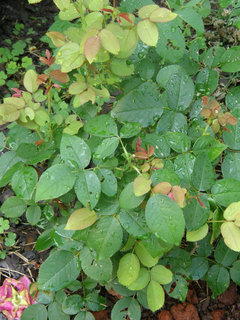
strawchicago z5
8 years agoMore pictures of growth-spurt with iron rich mulching: red lava rocks underneath, and cocoa mulch on top. Alfalfa meal produces growth spurt, but not as impressive as iron-rich products. Below is Madame Isaac Pereire. I count 6 buds in very shady spot (less than 4 hours sun). Bunnies ate 2 of the buds. I bought that as a band last August.

strawchicago z5
8 years agoSweet Promise growth-spurt with alfalfa-meal was mainly leaves, but Sweet Promise growth-spurt with iron & potassium rich-mulch produce more buds. The reddish growth is less than 1-week. Picture taken today June 19, after week-long rain:

strawchicago z5
8 years agoI see iron & potassium mulching (red lava rock & cocoa mulch) as most effective in red-roses, where the iron need is highest. Below if Yves Seedling (red rose) growth spurt, with many buds. It's 100% clean in month-long wet & humid weather. Picture taken today June 19:

strawchicago z5
8 years agolast modified: 8 years agoThe best evidence of iron for red-roses is Crimson Glory. Last month I dug that up, and moved it away from tree root. Winter-die-back was severe, down to 6 inches. I was foolish to put chicken manure, and the young shoot could not handle ... resulting in fertilizer-burn. It was stunt despite alfalfa and tons of rain. Finally I gave it cocoa mulch (high in iron. The growth spurt is less than a week:

strawchicago z5
8 years agolast modified: 8 years agoHi Msgirl: After 2 years testing red-lava-rock and cocoa mulch, I prefer cocoa-mulch, since it's a balanced fertilizer with cocoa mulch having 2.5 nitrogen, 1 of phosphorus, and 3 of potassium. The only draw back is it's acidic at pH 5.4, which can easily neutralized with gritty lime. Red-lava-rock is best MIXED in the planting hole, rather than on top. Cocoa mulch can't be mixed in the planting hole, since it acts like a glue and becomes too acidic when buried. Below is Christopher Marlow, 100% clean leaves, and lots of ruffles in the bloom, thanks to cocoa mulch. Picture taken today, July 15, after months of constant rain:
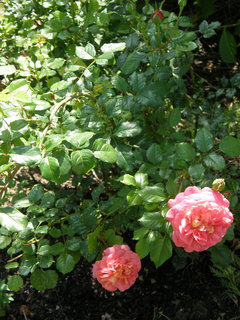


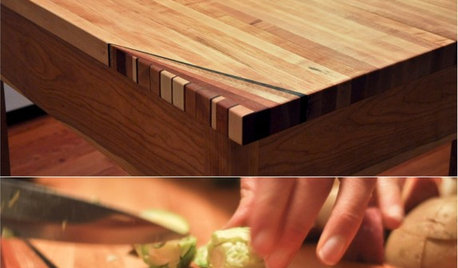
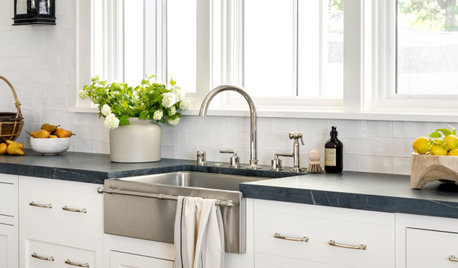
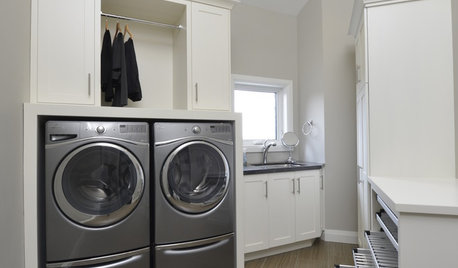
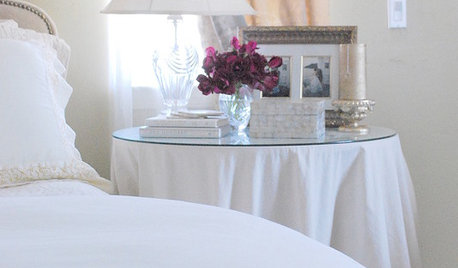
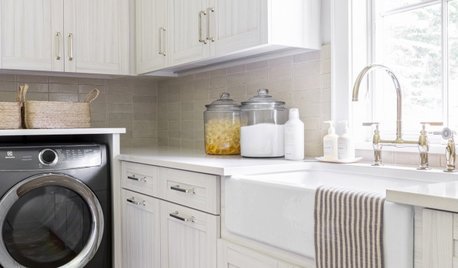
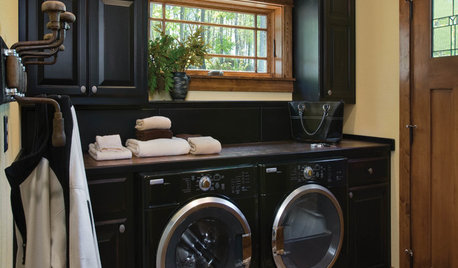
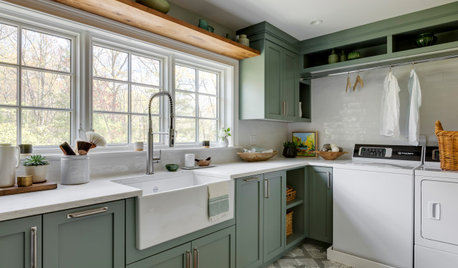
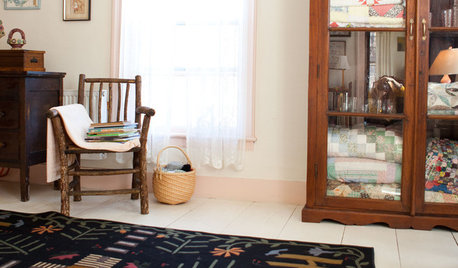








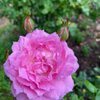
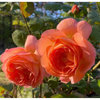
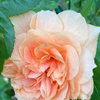

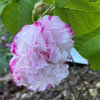
msdorkgirl